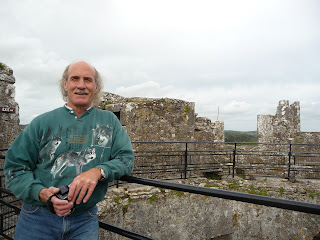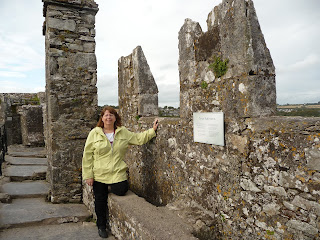




Barryscourt Castle, near Carrigtwohill in County Cork, with its largely intact bawn wall and corner towers, is a fine example of an Irish tower house. Both the first floor Main Hall and the second floor Great Hall have been extensively restored with fittings and furnishings reinstated. The Orchard has been restored to an original 16th century design and an herb garden has been reinstated in the bawn. The site on which Barryscourt castle now stands has been occupied for over a thousand years- there is evidence of a wooden watermill having been built next to a stream at the site sometime in the 7th century, long before any fortification existed there. The present Tower house at Barryscourt was probably built late in the reign of the Barrymores, either in the 15th or 16th century, with a tentative date of about 1550 based on the architectural style. We took a guided tour of the castle and it was quite fascinating and it was FREE!!
(the potty- it just "slid" to the outside of the castle - "watch out below")
Blackrock Castle, formerly Mahon Castle, is a 16th century castle located about 2km from the heart of Cork City on the banks of the River Lee. In the late 16th century, the citizens of Cork appealed to Queen Elizabeth I to construct a fort at Blackrock to "repel pirates and other invaders". In or around 1600, a round tower was constructed to safeguard against pirates "carrying away" vessels entering the harbour. Currently, Blackrock Castle houses Ireland's first fully interactive astronomy center.
Despite everything I read about avoiding driving in Cork City, we found ourselves smack dab in the middle of downtown at rush hour!! It was stop and go traffic all through town. There were people everywhere!
Blarney Castle was built nearly six hundred years ago by one of Ireland's greatest chieftains, Cormac MacCarthy, and has been attracting attention ever since. Over the last few hundred years, millions have flocked to Blarney, making it a world landmark and one of Ireland's greatest treasures. That might have something to do with the Blarney Stone, the legendary Stone of Eloquence, found at the top of our Tower. Kiss it and you'll never again be lost for words. It is a medieval stronghold in Blarney, near Cork City. Though earlier fortifications were built on the same spot, the current keep dates from 1446. Surrounding the castle are extensive gardens.


We found these very cool, huge trees all over Ireland!
Blarney House is a Scottish baronial-style mansion that was built on the grounds in 1874. It was an absolutely gorgeous home!!
Carrigadrohid Castle stands on a rock in the middle of the river Lee adjacent to the bridge which gives the village its name. It was erected in the 15th century by the MacCarthys of Muskerry, with an extension to the east and an annex to the north being added in subsequent centuries. It has been in ruins since the late 18th century. Carrigadrohid Castle is a tower house, a type of castle built extensively throughout Ireland in the Middle Ages, from the fifteenth to the seventeenth century. These tower houses were the fortified residences of local lords and chieftains, both of the native Irish families and the descendants of the Anglo-Norman settlers.
The Irish seem very "safety" conscious. Whenever there is water near a road, you will always find these life saver rings.
We are spending the night in Kinsale, County Cork at the Actons Hotel. We walked to a local restaurant, The White House, for dinner. It was a very popular place and was packed! We shared a bowl of very good fresh seafood chowder and I had a freshly caught lobster. It was a very nice dinner!

















No comments:
Post a Comment